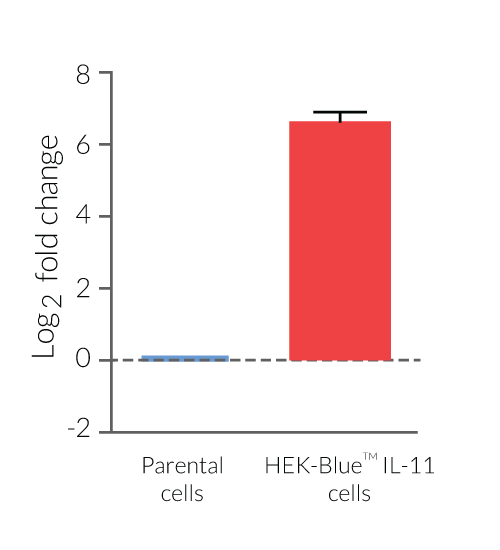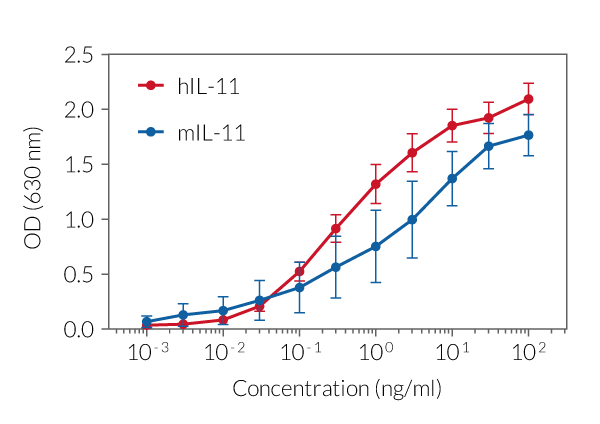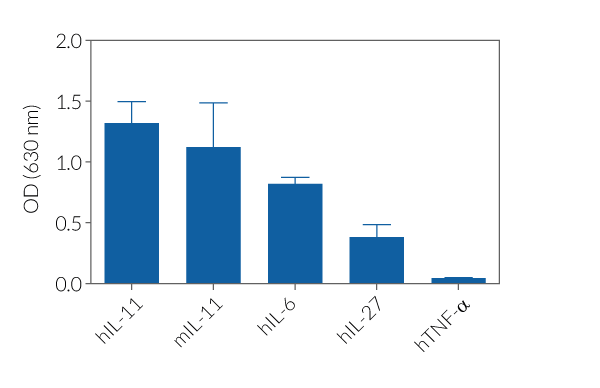IL-11 Reporter HEK 293 Cells
| Product | Unit size | Cat. code | Docs. | Qty. | Price | |
|---|---|---|---|---|---|---|
|
HEK-Blue™ IL-11 Cells Human IL-11 Reporter Cells |
Show product |
3-7 x 10e6 cells |
hkb-hil11r
|
|
||
|
HEK-Blue™ IL-11 vial Additional cell vial |
Show product |
3-7 x 10e6 cells |
hkb-hil11r-av
|
Notification: Reference #hkb-hil11-av can only be ordered together with reference #hkb-hil11.
Interleukin-11 Reporter Cells

Signaling pathway in HEK-Blue™ IL-11 cells
HEK-Blue™ IL-11 cells were engineered from the human embryonic kidney HEK 293 cell line to detect bioactive interleukin-11 (IL-11) by monitoring the activation of the JAK/STAT3 pathway. They can also be used for screening antibodies or small molecule inhibitors targeting the IL-11 pathway.
IL-11 has pleiotropic physiological functions, ranging from development and tissue homeostasis, to immune responses [1, 2].
Cell line description
HEK-Blue™ IL-11 cells were generated by stable transfection with the genes encoding the human IL-11 receptor (IL-11Rα and gp130 chains), human STAT3, and a STAT3-inducible secreted embryonic alkaline phosphatase (SEAP) reporter. The binding of IL-11 to its receptor triggers a signaling cascade leading to the activation of STAT3 and the subsequent production of SEAP. This can be readily assessed in the supernatant using QUANTI-Blue™ Solution, a SEAP detection reagent.
HEK-Blue™ IL-11 cells detect human and murine IL-11 (see figures). Of note, these cells also respond to human IL-6 and IL-27 as they express the gp130 co-receptor shared by IL-11 and other cytokines of the IL-6 family (see figures).
Key Features
- Fully functional IL-11 signaling pathway
- Readily assessable STAT3-inducible SEAP reporter activity
- Strong response to human (h) and mouse (m) IL-11
Applications
- Detection and quantification of hIL-11 and mIL-11 activity
- Screening of anti-IL-11 and anti-IL-11 receptor antibodies
- Screening of small molecule inhibitors of the IL-11 pathway
References:
1. Garbers C. & Scheller J., 2013. Interleukin-6 and interkeukin-11: Same same but different. Biol. Chem. 394:1145.
2. Kang S. et al., 2020. Historical overview of the interleukin-6 family cytokine. J. Exp. Med. 217: e20190347.
Specifications
Antibiotic resistance: Blasticidin, Hygromycin B, and Zeocin®
Growth medium: DMEM, 4.5 g/l glucose, 2 mM L-glutamine, 10% (v/v) heat-inactivated fetal bovine serum, 100 U/ml penicillin, 100 μg/ml streptomycin, 100 μg/ml Normocin®
Specificity: Detects human IL-11 and mouse IL-11
Detection range:
- Detection range for human IL-11: 0.1 ng/ml - 100 ng/ml
- Detection range for murine IL-11: 0.1 ng/ml - 100 ng/ml
Quality Control:
- The expression of human IL-11Rα is confirmed by RT-qPCR.
- SEAP reporter activity in response to IL-11 is validated using functional assays.
- The stability for 20 passages following thawing is confirmed.
- These cells are tested for mycoplasma contamination.
Contents
- 1 vial containing 3-7 x 106 cells
- 1 ml Normocin® (50 mg/ml)
- 2 x 1 ml of HEK-Blue Selection (250X)
- 1 ml of QB reagent and 1 ml of QB buffer (sufficient to prepare 100 ml of QUANTI-Blue™ Solution, a SEAP detection reagent).
![]() Shipped on dry ice (Europe, USA, Canada and some areas in Asia)
Shipped on dry ice (Europe, USA, Canada and some areas in Asia)
Details
The cytokine interleukin 11 (IL-11) belongs to the IL-6 family, which also includes IL-6, IL-27 p28/IL-30, IL-31, Leukemia inhibitory factor (LIF), Oncostatin M (OSM), Cardiotrophin-like cytokine (CLC), Ciliary neurotrophic factor (CNTF), Cardiotrophin-1 (CT-1), and Neuropoietin [1-3]. IL-11 has pleiotropic physiological functions, ranging from development and tissue homeostasis, to immune responses [1, 2]. IL-11 signalisation requires a multimeric structure comprising two specific α chains (IL-11Rα), two gp130 chains (common to the IL-6 signaling receptor), and 2 cytokines. This hexameric complex allows the juxtaposition of the intracellular Janus kinases (JAK) and activation of the signal transducer and activator of transcription 3 (STAT3) [1,3]. Other signaling pathways include the Ras-MAPK pathway, the PI3-K-Akt pathway, and the p38 and JNK MAPK pathways [2, 3].
While gp130 is ubiquitously expressed, IL-11Rα expression is cell-specific. Soluble IL-11Rα resulting from IL-11R proteolysis allows trans-signaling and widens the number of target cells [4]. Importantly, IL-11, like IL-6, has no affinity toward gp130 in the absence of its specific receptor α chain [1].
1. Garbers C. & Scheller J., 2013. Interleukin-6 and interkeukin-11: Same same but different. Biol. Chem. 394:1145.
2. Kang S. et al., 2020. Historical overview of the interleukin-6 family cytokine. J. Exp. Med. 217: e20190347.
3. Morris R. et al., 2018. The molecular details of cytokine signaling via the JAK/STAT pathway. Protein Science. 27:1984.
4. Lamertz L. et al., 2018. Soluble gp130 prevents interleukin-6 and interleukin-11 cluster signaling but not intracellular autocrine responses. Science Sign. 11(550):eaar7388).










